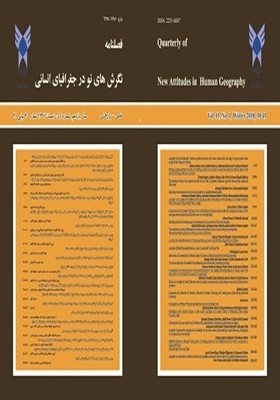تعیین تقویم زمانی اقلیم گردشگری در راستای توسعه و برنامه ریزی توریسم (مطالعه موردی: استان مرکزی)
محورهای موضوعی : کالبدی
1 - دانشیار جغرافیای طبیعی، گروه جغرافیا، واحد علوم و تحقیقات، دانشگاه آزاد اسلامی، تهران، ایران
کلید واژه: استان مرکزی, TCI, اقلیم گردشگری, واژگان کلیدی: تقویم زمانی, برنامه ریزی توریسم,
چکیده مقاله :
چکیده مطالعات اقلیمی نقش مهمی بر توسعه و برنامه ریزی توریسم ایفا مینماید. با ارزیابی اقلیم آسایش مناطق مستعد گردشگری میتوان تقویم اقلیم گردشگری استان مرکزی را تهیه کرده و جهت استفاده در برنامه ریزیهای زیر ساختی توسعۀ توریسم ارائه کرد. برای این پژوهش، 6 ایستگاه سینوپتیک (اراک، ساوه، خمین، تفرش، کمیجان و دلیجان) انتخاب شدند، سپس به ارزیابی اقلیم گردشگری استان مرکزی با استفاده از داده های اقلیمی مشترک ایستگاه های منتخب طی دوره آماری 10 ساله (1391- 1382) در محیط GIS با استفاده از شاخص TCI اقدام شد. همچنین نتایج حاصل از بررسی با شاخص TCI نشان داد که بهترین زمان برای جذب گردشگران به استان مرکزی ماههای مهر با کسب نمره TCI 92، خرداد با کسب نمره TCI 91، شهریور با کسب نمره TCI 89، اردیبهشت با کسب نمره TCI 88، دارای شرایط زیست اقلیمی عالی و ماههای تیر و مرداد با کسب نمره TCI 72 تا 74 دارای شرایط زیست اقلیمی خوب میباشند. در واقع اواسط بهار و تابستان و اوایل پاییز، بهترین شرایط توسعه گردشگری در منطقه مورد مطالعه فراهم است. در استان مرکزی بین ایستگاههای منتخب، ایستگاه تفرش از فراوانی شرایط آسایش بیشتری برای اقلیم گردشگری برخوردار است. ایستگاه تفرش 6 ماه از سال و ایستگاههای اراک، ساوه، خمین، کمیجان و دلیجان، 3 تا 4 ماه از سال در شرایط محیطی ایده آلی قرار دارند.
References
Amrollahi Buioki, Nahid and Nazari Dehaghi, Azam. (2015). City tourism image of its effects on the development of sustainable tourism, Tourism Management Studies Quarterly, Issue 31, pp. 103-129. [In Persian].
Berrittella Maria, Bigano Andrea, Roson Roberto, Tol Richa rd S.J. ) 2006). A general equilibrium analysis of climate change impacts on tourism, Tourism Management, Vol. 27, pp: 913-924
Ezzatian, Victoria, Mirenait, Nahid Sadat and Hajian, Mohamad Kazem (2011). Biology OF Climate Tourism kohgiloyeh using TCI, Journal of tourism space, Volume 1, Issue 3, pp. 139- 161. [In Persian]
Fani, Zohreh, Alizadeh tooli, Mohammad and Zahmatkesh, Zainab. (2013). Impact of tourism on sustainable urban development in terms of residents (case study: Qeshm Island), Tourism Management Studies Quarterly, Volume IX, Issue 28, pp. 39-72. [In Persian].
Farajzadeh, Manochehr and Ahmedabadi, Ali. (2009). Tourism Climate Assessment and Zoning of Iran using TCI (TCI), Journal of Physical Geography, Issue 71, pp. 31-42. [In Persian]
Farajzadeh, Manochehr, Razaqi, Marjan, Fathnia, Aman Ullah and Ahmadabadi, Ali. (2008). Analysis of variability climatourism index of drought and wet conditions, Journal of Geography and Regional Planning, Vol. 1, pp. 57. 71. [In Persian]
Fotoohi, Samad, Zahraei, Akbar and Ebrahimi Tabar, Ebrahim. (2012). Tourism climate conditions of northern Caspian Sea, the geo-spatial Journal, Volume 13, Issue 42, pp. 169 189. [In Persian]
Gandomcar, Amir (2009). Estimation of the city Samirom using the model TCI, Journal of Physical Geography, Vol. 3, No. 8, pp. 99. 110. [In Persian]
Hasanvand, Abbas Solimani tabar, Maryam and yazdanpanah, Hojat. (2010). Spatial interpretation of climatic comfort of Lorestan province based on TCI, Spatial Planning Magazine, Issue 1, Volume 1, pp. 121-144. [In Persian].
Hartz Donna A., Brazel Anthony J., and Heisler Gordon M. (2006). A case study in resort climatology of Phoenix, Arizona, USA, International Journal of Biometeorology, Vol. 51, pp: 73-83.
Jacqueline, Hamilton, M., and Richard SJ Tol. (2007). The impact of climate change on tourism in Germany, the UK and Ireland: a simulation study, Regional Environmental Change, Vol.7, pp: 161-172.
Khoshhal Dastjerdi, Javad., Ghazi, Iran and arwin, Abas. (2005). The use of cluster grouping in the human bioclimatic zoning (Case Study: Isfahan Province), Journal of Research, Volume 20, Issue 1, Pages. 178- 186. [In Persian].
Markazi Province Meteorological Organization (2015). Statistics climate stations in Markazi Province [In Persian].
Matzarakis, A. (2007). Assessment method for climate and tourism based on daily data, Developments in tourism climatology.
Maureen Agnew D., and Jean P. Palutikof. (2001). Climate impacts on the demand for tourism, International Society of Biometeorology Proceedings of the First International Workshop on Climate, Tourism and Recreation. Retrieved from http://www. Mif. Uni-freiburg. De/isb/ws/report. Htm.
Nasrollahi, Zahra, Jahanbazi, Neda, Naseri, Tahereh. (2013). Classification provinces in terms of Tourist Attractions, Tourism Management Studies Quarterly, Year IX, No. 28, pp. 17-37. [In Persian].
Omrani, Zainab and Yazdanpanah, Hojatolah. (2012). Determine the calendar of tourism climate tourist areas in Isfahan province, Journal geographical space, in Issue 41, pp. 113: 130. [In Persian]
Scott, D., McBoyle, G., and Schwartzentruber, M. (2004). Climate Change and the Distribution of Climatic Resources for Tourism in North America, Climate Research, No, 7, pp: 105–117.
Shams, Majaid., Safari Rad, Ali and Ghasemi, Ahmad. (2013). Tourism in Mashhad assessment of climate conditions using thermal comfort indices, geo-spatial Journal tourism, Volume 3, Issue 10, pp. 91: 104. [In Persian]
Zahirinia, Mostafa. and Nikkhah, Hedait Allah (2014). The attitudes of residents of Bandar Abbas on the impacts of tourism, Tourism Management Studies Quarterly, Issue 32, pp. 43-65. [In Persian]
Zengin, Murat., Ibrahim Kopar., and Faris Karahan. (2010). Determination of bioclimatic comfort in Erzurum–Rize expressway corridor using GIS, Building and Environment, Vol.45, pp: 158-164.
Zolfaghari, Hasan. (2006). Determine the right time to turn the calendar in Tabriz using PET and PMV, Geographical Journal, Issue 62, pp. 129: 142. [In Persian]


